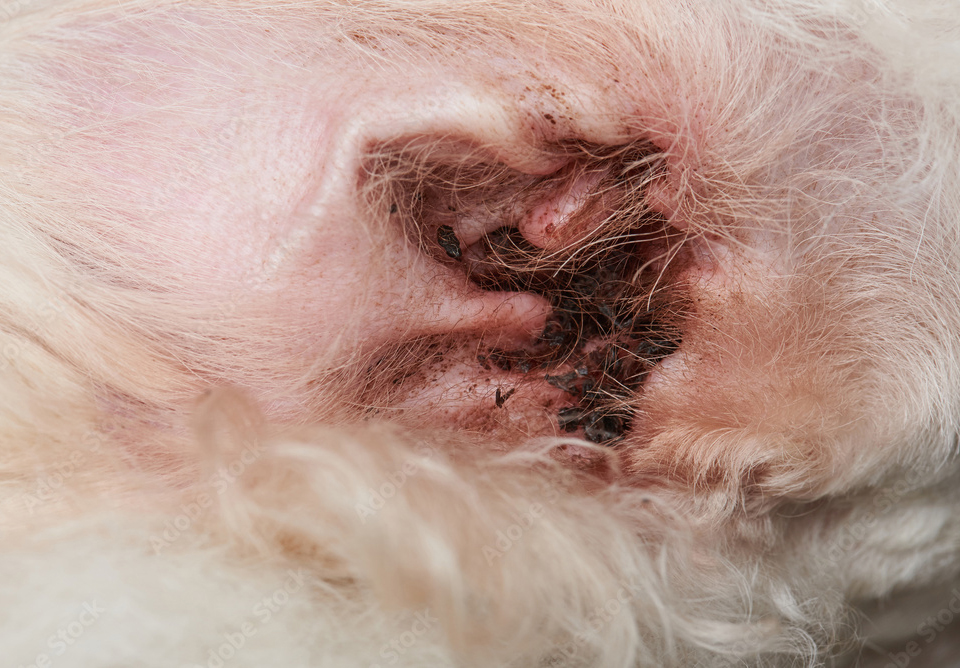
Ear Infection / Irritation?
Open 7-Days a Week, 6:30am – 8:00pm
727-738-2273
Ear infections are incredibly common in dogs in certain dog breeds. In fact, as many as 20 percent of dogs have some form of ear disease, at any time. However, most ear infections go undiagnosed or ignored, with the hope that it might heal on it’s own. Without a thorough inspection and explanation of the complexities behind many ear infections though, it’s hard to know how dangerous the infection actually is.
- Dogs are more prone to ear infections than humans because of the shape of their ear canals
- Prevention is key — learn how to clean your dog’s ears safely
- If your dog is showing any of the common signs of ear infections, it’s important to call us as soon as possible
There are 3 types of ear infections, known formally as otitis externa, media, and interna.
- The most common is otitis externa, in which inflammation affects the layer of cells lining the external portion of the ear canal.
- Otitis media and interna refer to infections of the middle and inner ear canal, respectively. These infections often result from the spread of infection from the external ear.
- !! Otitis media and interna can be very serious and may result in deafness, facial paralysis, and vestibular signs. That’s why it’s important to prevent infections and seek early treatment when problems arise.
Healthy adult pets with “normal” ear anatomy almost never get ear infections. It is reasonable to treat the first infection that a dog or cat gets as a random event, but if the infection returns or fails to promptly resolve with appropriate therapy, a search for the underlying cause should commence. Bacterial and/or yeast infections are much more likely.
Have the Ears Cleaned Properly, By Your Veterinarian
Ear Infections Are Typically the Result of Another Problem
In most cases, a pet’s ear infection should be viewed as a symptom of another, underlying condition. Allergies to ingredients in the pet’s food, or environmental triggers, like pollen, molds, and dust mites, are most common, but anatomical abnormalities, masses, foreign material within the ear, chronically damp ears, and hormonal disorders are also possible.
There are several kinds of bacteria and at least one type of fungus that commonly cause ear infections. Without knowing the specific kind of infection present, it is not possible to know which medication to use. In some cases, the problem is a foreign body, a polyp, or a tumor. Treatment with medication alone will not resolve these problems. It is important that your dog be examined to ensure that the eardrum is intact. Administration of certain medications can result in loss of hearing if the eardrum is ruptured. This can only be detected by a thorough ear examination by your veterinarian.
What Causes Ear Infections in Dogs?
The ear canal of a dog is deeper, and more vertical than that of a human, forming an L-shape that tends to hold in fluid. This makes dog’s ears more prone to infection. Ear infections are typically caused by bacteria, yeast, or a combination of both. In puppies, ear mites can also be a source of infection.
Chronic or recurrent ear infections in dogs can be an indication of allergies or low thyroid function (hypothyroidism). Factors that may predispose your dog to ear infections include:
- Water or moisture, which can create a prime growing environment for bacteria and yeast
- Allergies, which leads to ear disease in about half of dogs with allergic skin disease and 80 percent of dogs with food sensitivities
- Endocrine disorders, such as thyroid disease
- Autoimmune disorders
- Wax buildup
- Foreign bodies
- Injury to the ear canal
- Excessive cleaning
Typical symptoms include:
- Brown or yellowish discharge
- Redness
- Scabs or crusty ears
- Head shaking
- Scratching at the affected ear
- Odor
- Redness and swelling of the ear canal
- Pain
- Crusting or scabs in the ears
More extreme symptoms include hearing loss, loss of balance, and strange eye movements. Ear infections are often signs of an underlying condition. “Allergies to ingredients in the pet’s food, or environmental triggers, like pollen, molds, and dust mites, are most common, but anatomical abnormalities, masses, foreign material within the ear, chronically damp ears, and hormonal disorders are also possible.”
What Happens If It’s NOT Treated?
Deep ear infections can damage or rupture the eardrum, causing an internal ear infection and even permanent hearing loss. Additionally, if a dog’s ears are a constant source of pain or irritation, the constant shaking and scratching of the ears can lead to a condition called an ‘aural hematoma‘ in which blood vessels in the ear flap break, causing a painful swelling that requires surgical treatment.
